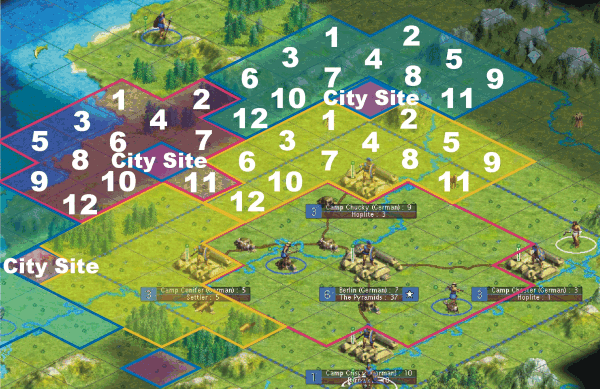Originally posted by Smirk
Its a tough estimate but I think for the early game the inner ring will benefit more by better placement than equal distance from the capital, for instance settling on a river shieldland is a big loss.
I certainly think this is a reasonable alternative. The larger the number of cities in the ring, the more important to have them all at the same distance (i.e., the larger the benefit from RCS over random placement). The outer ring (generally) has more cities, so exact placement is more important there.
That said, I find in a couple of tries that it can work pretty well to stick with a fixed distance for the inner ring, but not build all the sites. If you choose a small ring, then it may well have more sites than the number of cities you really want to have that close in, and they overlap quite a bit, so the ring cities on either side can generally use the spaces from the cities you leave out. For example, in GOTM20, I had an inner ring at distance 3.5; there are 8 sites at that distance; one was unbuildable water; one was on the edge of the coast and would have mostly had water spaces available to it; one was surrounded by a fair amount of desert which isn't that valuable to work; so I only built on the other 5. Also of course I chose the 3.5 distance based on the fact that it worked well on this particular map, particularly considering the resources and the availability of fresh water.
[Note Added: the ICS style is to build even more cities than this, but I think that ICS in the inner core (as opposed to farther out) isn't particularly compatible with RCP; RCP gets its benefit from having a ring with a lot of cities with low corruption, and so it doesn't really make sense to have a bunch of small cities close in, not producing all that much (because they are all small) but adding corruption to all of the cities in the outer ring.]
BTW, I don't particularly agree that settling on a river shield grassland is a bad location. Once you grow to size 7, the city core generates an extra shield for the shield on the terrain, so settling on the shield grassland and operating an adjacent regular grassland gives you just the same result as settling on the regular grassland and operating the shield grassland. When your city is smaller than that, you do potentially lose a shield, but often when your city is small you have several reasonable tiles to work anyway.
And, aside from the shield, settling on rivers is much better than settling away from them.
With that in mind and with what others have said this may be best used for your FP and/or palace jump for midgame or later.
In GOTM20 I found that the game went so fast, and my main core was so productive, that I had the game well in hand before I got any significant amount of output from my second (FP) core. I think that if you're playing fairly aggressively, that this may end up being true pretty consistently: you can already roll over the AIs by the time you get your second core going. Perhaps this will be less true on huge maps; I'm not sure.
On a completely difference note, I can't say I like the looks of this strategy in that if it is much better than "normal" placements its going to require everyone to use it to stay competative, which reduces the variability of the game greatly. And then removes one of the most hotly contended facets of the game, city placement.

I don't really think that RCP does remove much variability. Several people have expressed an intention to try some form of RCP in GOTM21. It will be interesting to see what those games look like, but my suspicion is that they will all look quite different. There are still a lot of choices to make.
Since there would be no way to enforce this as an exploit I think this is merely a code bug, even when two cities are the same distance they are still ordered in some fashion and the 3rd city is still the 3rd city, this is more a fault of the corruption algorithms than a plain error on firaxis' part.
As you say, it's hard to ban: How can you tell people they can't build cities where they like? So unless Firaxis decides to change the formulas in a patch, I think it's just something we have to live with, for better or worse. I don't think it makes the games less fun on its own, but I do think that perhaps it's one of a number of game techniques that people are learning to take advantage of that all together are too powerful, making the game too easy to win quickly and decisively, even at high difficulty levels. Every technique that we discover and refine and that the AI doesn't understand and can't use, puts it at more and more of a competitive deficit. That's sort of too bad, but I don't see what to do about it.








